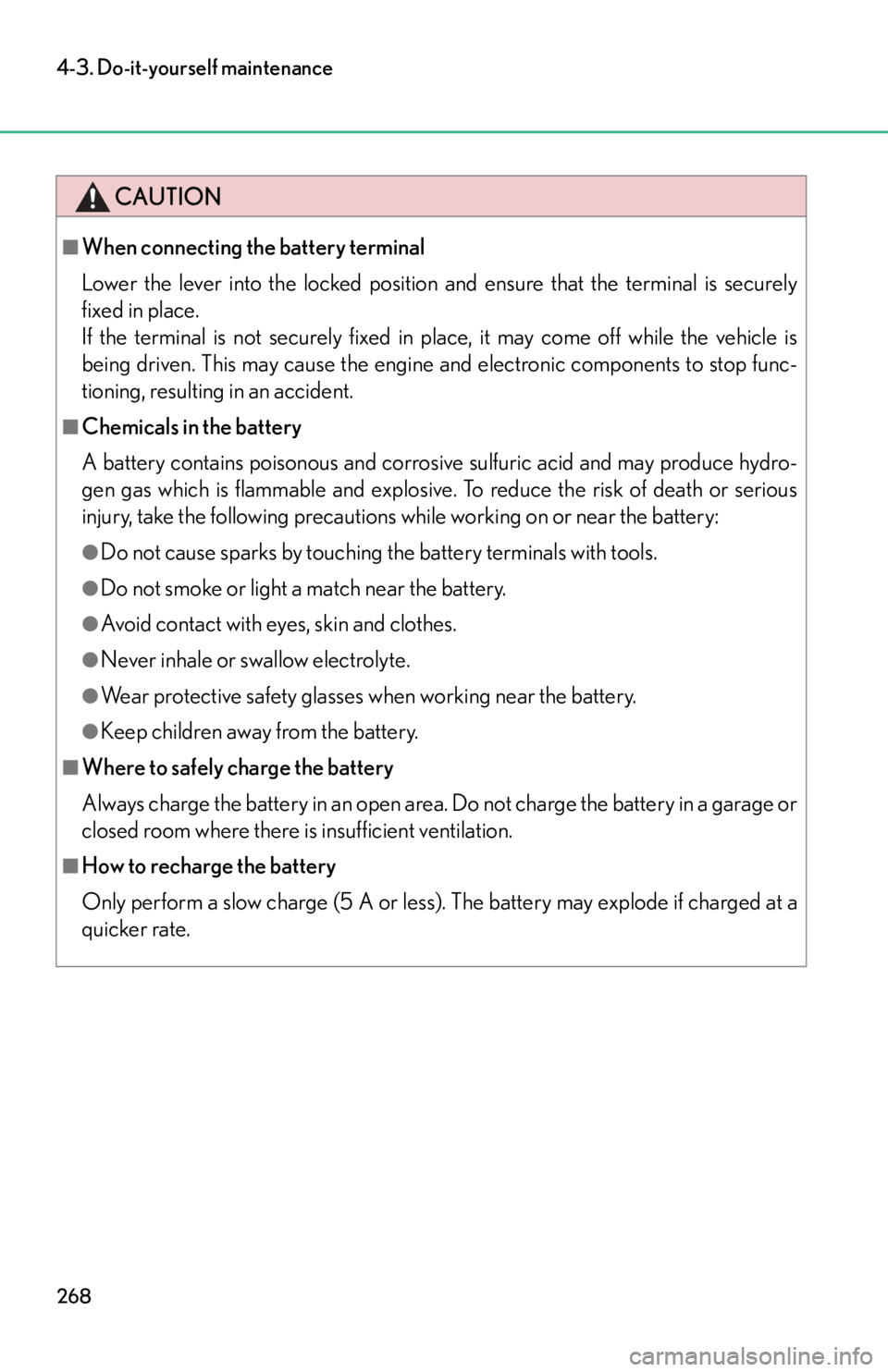Page 268 of 420

266
4-3. Do-it-yourself maintenance
■Before recharging
When recharging, the battery produces hydrogen gas which is flammable and
explosive. Therefore, observe the following precautions before recharging:
●If recharging with the battery installed on the vehicle, be sure to disconnect the
ground cable.
●Make sure the power switch on the charger is off when connecting and discon-
necting the charger cables to the battery.
■If the vehicle is not used for an extended period of time
Removing the specified fuse helps to supp ress parasitic current (the draw on the
battery when the vehicle is shut off).
Turn the ignition switch to the “LOCK” position.
Open the fuse box lid in the engine compartment. ( P. 2 8 7 )
Before commencing driving again, make sure to return the fuse to its original posi-
tion.
STEP1
STEP2
While referring to “Fuse layout and amper-
age ratings” ( P. 290) or the back of the
fuse box lid for the location, use the pull-out
tool to remove the “D/C CUT” fuse
and put it into .
Make sure that the fuse is firmly inserted.STEP3
Page 270 of 420

268
4-3. Do-it-yourself maintenance
CAUTION
■When connecting the battery terminal
Lower the lever into the locked position and ensure that the terminal is securely
fixed in place.
If the terminal is not securely fixed in place, it may come off while the vehicle is
being driven. This may cause the engine and electronic components to stop func-
tioning, resulting in an accident.
■Chemicals in the battery
A battery contains poisonous and corrosive sulfuric acid and may produce hydro-
gen gas which is flammable and explosive. To reduce the risk of death or serious
injury, take the following precautions while working on or near the battery:
●Do not cause sparks by touching the battery terminals with tools.
●Do not smoke or light a match near the battery.
●Avoid contact with eyes, skin and clothes.
●Never inhale or swallow electrolyte.
●Wear protective safety glasses when working near the battery.
●Keep children away from the battery.
■Where to safely charge the battery
Always charge the battery in an open area. Do not charge the battery in a garage or
closed room where there is insufficient ventilation.
■How to recharge the battery
Only perform a slow charge (5 A or less). The battery may explode if charged at a
quicker rate.
Page 271 of 420

269
4-3. Do-it-yourself maintenance
4
Maintenance and care
CAUTION
■Emergency measures regarding electrolyte
●If electrolyte gets in your eyes
Flush your eyes with clean water for at least 15 minutes and get immediate medi-
cal attention. If possible, continue to apply water with a sponge or cloth while
traveling to the nearest medical facility.
●If electrolyte gets on your skin
Wash the affected area thoroughly. If you feel pain or burning, get medical atten-
tion immediately.
●If electrolyte gets on your clothes
It can soak through clothing on to your skin. Immediately take off the clothing and
follow the procedure above if necessary.
●If you accidentally swallow electrolyte
Drink a large quantity of water or milk. Fo llow with milk of magnesia, beaten raw
egg or vegetable oil. Get emergency medical attention immediately.
■When replacing the battery
Use a battery designed for the LFA. Failure to do so may cause gas (hydrogen) to
enter the passenger compartment, causing a fire or explosion.
For replacement of the battery, contact your Lexus dealer.
NOTICE
■Before disconnecting the battery terminal
Turn the ignition switch to the “LOCK” position and check that the gear indicator
turns off before disconnecting the battery terminal.
If the terminal is disconnected while the gear indicator is still displayed, the ASG
(Automated Sequential Gearbox) computer may be negatively affected, possibly
causing the engine not to start. If the term inal is accidentally disconnected while the
indicator is on, contact your Lexus dealer.
■When recharging the battery
Never recharge the battery while the engine is running. Also, be sure all accesso-
ries are turned off.
Page 289 of 420
287
4-3. Do-it-yourself maintenance
4
Maintenance and care
Checking and replacing fuses
If any of the electrical components do not operate, a fuse may have blown. If
this happens, check and replace the fuses as necessary.
Turn the ignition switch to the “LOCK” position.
Open the fuse box lid.
Engine compartment Push the tabs in and lift the lid off.
Driver's side instrument panel Remove the lid.
Passenger's side instrument panel Remove the lid.STEP1
STEP2
Page 290 of 420
288
4-3. Do-it-yourself maintenance
Luggage compartmentRemove the lid.
After a system failure, see “Fuse layout and amperage ratings”
( P. 290) for details about which fuse to check.
Remove the fuse with the pull-out
tool.
The pull-out tool is in the fuse box
of the engine compartment.
Check if the fuse has blown.
Ty p e A Normal fuse
Blown fuse
Replace it with one of an appropri-
ate amperage rating. The amper-
age rating can be found on the fuse
box lid.
STEP3
STEP4
STEP5
Page 292 of 420
290
4-3. Do-it-yourself maintenance
Fuse layout and amperage ratings■ Engine compartment
FuseAmpereCircuit
1INJ 10 AMultiport fuel injection system/
sequential multiport fuel injection sys-
tem, noise filter
2A/PMP HTR 20 A Multiport fuel injection system/
sequential multiport fuel injection sys-
tem
3EFI
20 AMultiport fuel injection system/
sequential multiport fuel injection sys-
tem
4A/F HTR 10 A
Multiport fuel injection system/
sequential multiport fuel injection sys-
tem
5SPARE
30 A Spare fuse
6SPARE 20 A Spare fuse
7SPARE 10 A Spare fuse
Page 303 of 420

When trouble arises5
301
5-1. Essential informationEmergency flashers.............. 302
If your vehicle needs to be towed................................ 303
If you think something is wrong ..................................... 308
Fuel pump shut off system .................................... 309
Event data recorder ............... 310 5-2. Steps to take in an
emergency
If a warning light turns on or a warning buzzer
sounds... .................................. 312
If a warning message is displayed................................ 322
If you have a flat tire............... 332
If the engine will not start .... 343
If you lose your keys/ wireless remote
control transmitter ............. 344
If the parking brake cannot be released ............. 345
If the vehicle battery is discharged ............................ 348
If your vehicle overheats ...... 351
If the vehicle becomes stuck........................................ 354
If your vehicle has to be stopped in an
emergency ............................ 355
Page 304 of 420
302
5-1.Essential information
Emergency flashers
Use the emergency flashers if the vehicle malfunctions or is involved in an
accident.
Press the switch to flash all the turn
signal lights. To turn them off, press
the switch once again.
NOTICE
■To prevent battery discharge
Do not leave the emergency flashers on longer than necessary when the engine is
not running.